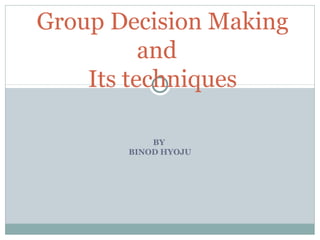
Group Decision Making Techniques and Models Explained
- 1. Group Decision Making and Its techniques BY BINOD HYOJU
- 2. Group Problem-Solving Model a conceptual framework for addressing problems Air everyone’s concerns Look beyond the symptoms Explore all solutions Anticipate problems Follow through Work productively
- 3. Individual Decision Making even within the group Autocratic Consultation Joint Decision Delegation
- 4. The Decision Process Problem solving Buying process recognition of the need e.g a new Laptop (PC) choice of involvement level (time and effort justified) e.g. two week ends identification of alternatives e.g. Dell, Hp, Acer, Mac, PC World evaluation of alternatives I.e. price, customer service, software support, printer/scanner package decision - choice made e.g Mac action e.g buy Mac (Macbook, Macbook pro Macbook air)model from Apple Machintosh post-purchase behaviour I.e. use, breakdowns, results evaluation etc
- 5. Problem-solving process Identify the problem Diagnose the problem Develop solutions Select a solution Implement the solution Evaluate the outcomes
- 6. Basic Consensus Technique Agreement Seeking: A consensus decision making process attempts to help participants reach as much agreement as possible. Collaborative: Participants contribute to a shared proposal and shape it into a decision that meets the concerns of all group members as much as possible. Cooperative: Participants in an effective consensus process should strive to reach the best possible decision for the group and all of its members, rather than competing for personal preferences.
- 7. Basic Consensus Egalitarian: All members of a consensus decision-making body should be afforded, as much as possible, equal input into the process. All members have the opportunity to present, and amend proposals. Inclusive: As many stakeholders as possible should be involved in the consensus decision- making process. Participatory: The consensus process should actively solicit the input and participation of all decision-makers
- 8. Brainstorming Prepare for the Brainstorming Determine the Brainstorming Method to use Generate Ideas Create Filters Apply Filters Wrap up
- 9. Brainstorming Rules Focus on quantity: This rule is a means of enhancing divergent production, aiming to facilitate problem solving through the maxim quantity breeds quality. The assumption is that the greater the number of ideas generated, the greater the chance of producing a radical and effective solution. Withhold criticism: In brainstorming, criticism of ideas generated should be put 'on hold'. Instead, participants should focus on extending or adding to ideas, reserving criticism for a later 'critical stage' of the process. By suspending judgment, participants will feel free to generate unusual ideas.
- 10. Brainstorming Rules Welcome unusual ideas: To get a good and long list of ideas, unusual ideas are welcomed. They can be generated by looking from new perspectives and suspending assumptions. These new ways of thinking may provide better solutions. Combine and improve ideas: Good ideas may be combined to form a single better good idea. It is believed to stimulate the building of ideas by a process of association.
- 11. Nominal Group Technique Define the problem to be solved/decision Silently generate ideas State and record ideas Clarify each on the list Rank items silently; list rankings Tally rankings Wrap up
- 12. Nominal Group Technique Process Introduction and explanation: The facilitator welcomes the participants and explain to them the purpose and procedure of the meeting. Silent generation of ideas: The Facilitator provides each participant with a sheet of paper with the question to be addressed and ask them to write down all ideas that come to mind when considering the question. During this period, the facilitator asks participants not to consult or discuss their ideas with others.
- 13. Nominal Group Technique Process Sharing ideas: The Facilitator invites participants to share the ideas they have generated. He records each idea on a flip chart using the words spoken by the participant. The round robin process continues until all ideas have been presented. There is no debate about items at this stage and participants are encouraged to write down any new ideas that may arise from what others share. This process ensures all participants get an opportunity to make an equal contribution and provides a written record of all ideas generated by the group. Group discussion: Participants are invited to seek verbal explanation or further details about any of the ideas that colleagues have produced that may not be clear to them. The facilitator’s task is to ensure that each person is allowed to contribute and that discussion of all ideas is thorough without spending too long on a single idea. It is important to ensure that the process is as neutral as possible, avoiding judgment and criticism. The group may suggest new items for discussion and combine items into categories, but no ideas should be eliminated.
- 14. Nominal Group Technique Process Voting and ranking: This involves prioritizing the recorded ideas in relation to the original question. Following the voting and ranking process, immediate results in response to the question is available to participants so the meeting concludes having reached a specific outcome.
- 15. Paired Choice Matrix Identify the issue, options, goals Prepare for the session Make decisions between pairs Tally scores of paired choices Discuss and clarify results Wrap up
- 16. Criteria Rating Technique Start session and list alternatives Brainstorm decision criteria Discuss the relative importance of each criteria Establish a rating scale, then rate the alternatives Calculate the final score Select the best alternative Wrap up
- 17. The Delphi Technique Define the decision or problem Team provides Round 1 input Summarize Round 1: ask for Round 2 input Team provides Round 2 input Summarize Round 2: ask for Round 3 input Team provides Round 3 input Summarize Round 3 Wrap Up
- 18. THANK YOU